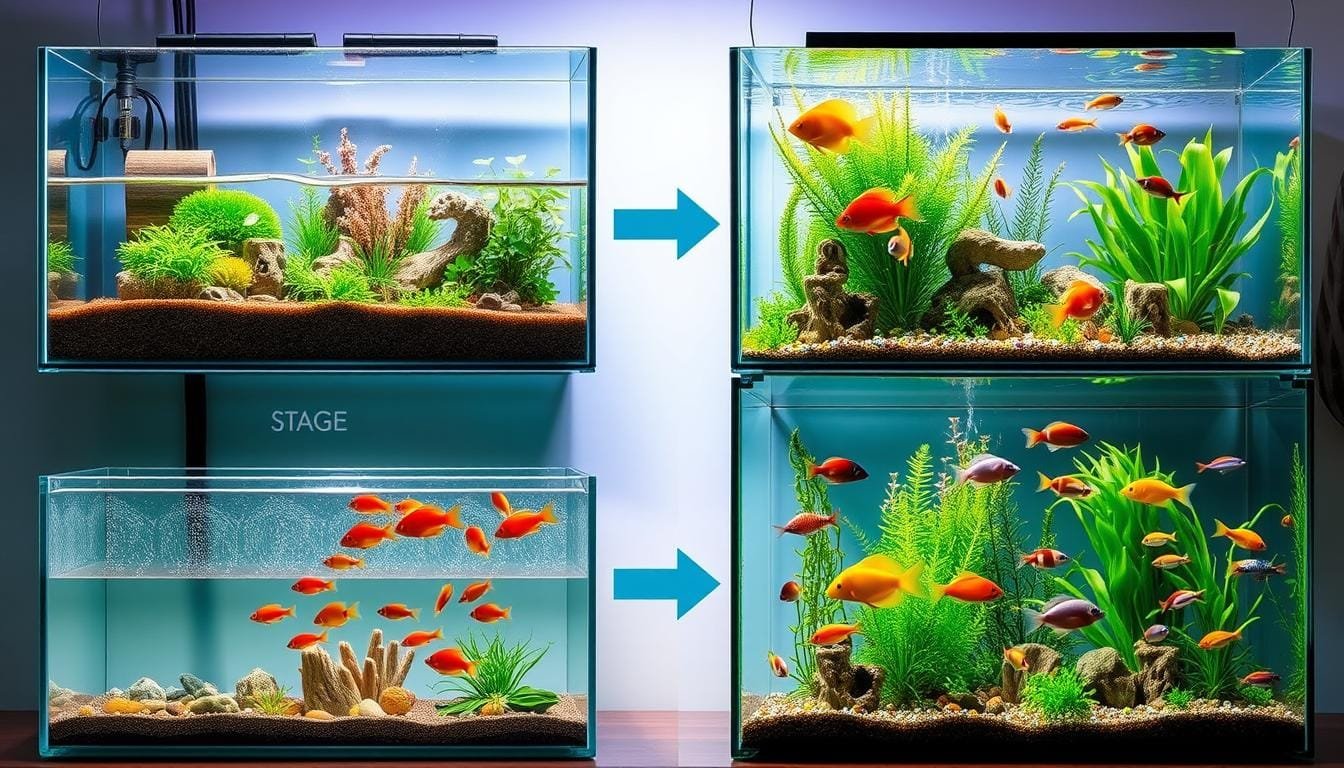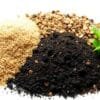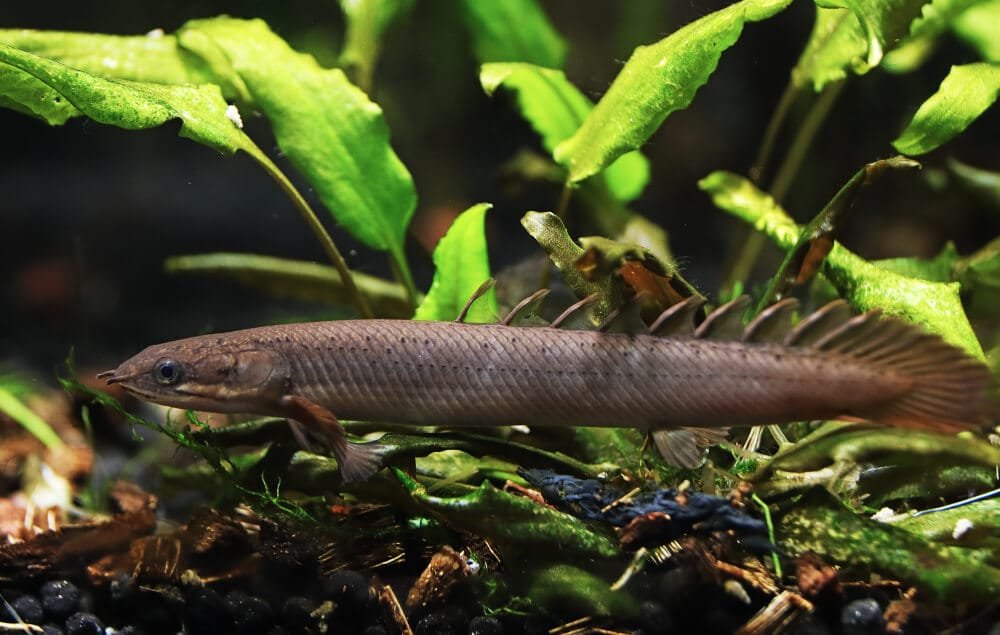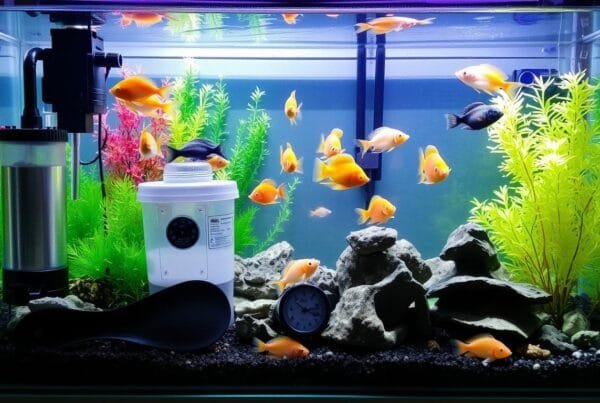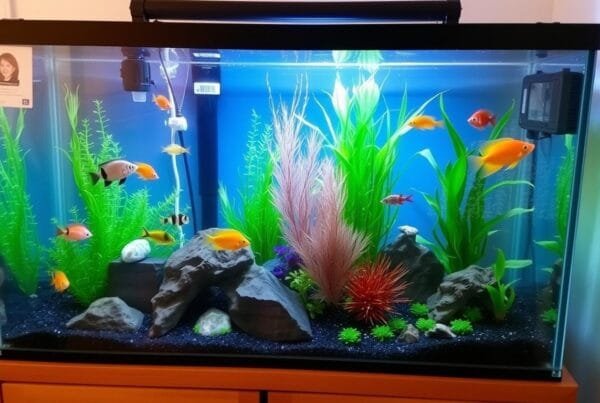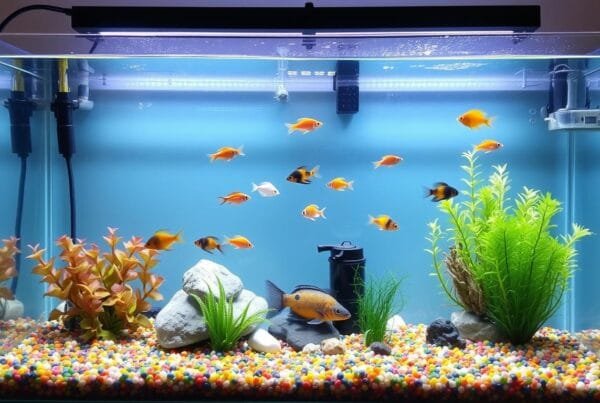Did you know 90% of aquarium failures come from not cycling properly? Learning about the fish tank cycling process is key to a thriving underwater world. Cycling a new tank is not just a tip—it’s essential for a healthy home for fish.
The aquarium nitrogen cycle is the base of a successful fish tank. It turns harmful waste into safer compounds, keeping your fish safe. By learning how to cycle a new tank, you avoid “new tank syndrome,” a deadly buildup of toxins.
Cycling a tank usually takes 4 to 6 weeks, depending on conditions and methods. During this time, good bacteria grow and change dangerous ammonia into safer nitrates. Being patient and watching your tank closely is vital for a safe home for your fish.
Special test kits are your allies during cycling. They help you check important water levels like ammonia, nitrite, and nitrate. With the right care and tools, you’ll turn an empty tank into a lively, balanced home for marine life.
Understanding Aquarium Cycling: The Foundation of a Healthy Tank
Aquarium cycling turns an empty tank into a lively home for fish. It’s all about adding good bacteria that keep the water safe. Knowing the nitrogen cycle is key to a healthy aquarium setup and happy fish.
What is the Nitrogen Cycle?
The nitrogen cycle is a natural process. It turns harmful waste into safer stuff. It starts when fish poop and uneaten food breaks down, making ammonia.
- Ammonia is highly toxic to fish
- Beneficial bacteria convert ammonia into nitrites
- Additional bacteria transform nitrites into nitrates
Why Cycling is Essential for Fish Health
Cycling stops New Tank Syndrome, a deadly condition. It happens when ammonia and nitrite levels are too high. Experts say new tanks need 4 to 6 weeks to cycle before adding fish.
The Role of Beneficial Bacteria
Aquarium bacteria are the heroes of the tank. They make a biological filter that turns bad waste into safe stuff.
| Bacterial Type | Function | Optimal Conditions |
|---|---|---|
| Nitrosomonas | Converts Ammonia to Nitrites | pH 6.5-8.0, Temp 75-80°F |
| Nitrobacter | Converts Nitrites to Nitrates | pH 6.5-8.0, Temp 75-80°F |
*About 70% of aquarium hobbyists choose fishless cycling to keep fish safe.*
By learning and using the right cycling methods, you can make a stable, healthy home for your fish. This ensures a long, happy life for your aquatic pets.
Essential Equipment and Supplies for Tank Cycling
Setting up a successful aquarium needs careful equipment and supply selection. The cycling process requires specific tools for a healthy environment. It’s important to know the key components for bacterial growth and water quality.

Choosing the right filter media is key for beneficial bacteria. The Seachem Tidal Filter is a great choice for efficient filtration during cycling.
- Essential Cycling Equipment:
- High-quality aquarium filter
- Reliable aquarium heater
- Comprehensive aquarium test kit
- Water conditioner
- Aquarium substrate
Water chemistry needs precise management. A good aquarium test kit is vital for monitoring during cycling. Seachem Prime is a top water conditioner, removing harmful chlorine and chloramine.
| Equipment | Purpose | Recommended Action |
|---|---|---|
| Filter Media | Bacterial Colonization | Choose porous, surface-rich media |
| Water Conditioner | Chlorine Removal | Treat water before adding to tank |
| Aquarium Substrate | Bacterial Growth Surface | Select fine-grained, nutrient-rich substrate |
“Proper equipment is the foundation of a successful aquarium cycling process.” – Aquarium Experts
When picking aquarium substrate, look for materials with lots of surface area for bacteria. The right equipment mix creates a stable environment for bacteria and future fish health.
The Three Stages of the Nitrogen Cycle Explained
Knowing the nitrogen cycle is key to a healthy aquarium. It changes toxic ammonia into safer compounds through bacterial actions.
Ammonia Production Phase
The cycle starts with ammonia production. Fish waste and decaying matter create ammonia, which harms fish. Good aquarium water chemistry means watching ammonia levels closely.
- Healthy tanks should have almost no ammonia.
- At first, ammonia can be up to 3 ppm.
- Starting to decay, fish food makes ammonia quickly.
Nitrite Conversion Process
Some bacteria turn ammonia into nitrite, a harmful compound. Testing for nitrite starts about a week after adding organic matter.
| Stage | Bacterial Action | Ideal Levels |
|---|---|---|
| Ammonia to Nitrite | Nitrosomonas bacteria | 0 ppm |
| Nitrite Conversion | Nitrobacter bacteria | 0 ppm |
Nitrate Formation Stage
The last step turns nitrite into nitrate, a safer compound. Regular water care helps keep nitrate levels in check.
“A well-balanced aquarium is a delicate ecosystem requiring careful attention to nitrogen compounds.”
Nitrate levels should stay under 40 ppm. If they go over, a 20% water change is needed to keep the water healthy.
How to Cycle a Fish Tank Properly
Cycling a fish tank is key to a healthy aquarium. The fishless cycling method is the best way to start a new tank. It involves adding ammonia to mimic fish waste and help beneficial bacteria grow.
- Start by adding pure ammonia to your tank
- Maintain ammonia levels around 3 parts per million (ppm)
- Test water parameters every few days
- Monitor nitrogen cycle progression
The cycling process takes patience and careful watching. It usually lasts 4 to 6 weeks. You’ll need to track water parameters closely during this time.
| Cycling Stage | Target Levels | Duration |
|---|---|---|
| Ammonia Introduction | 3 ppm | 1-2 weeks |
| Nitrite Conversion | < 1 mg/L | 2-3 weeks |
| Nitrate Formation | Above 0 ppm | Final 1-2 weeks |
*Pro tip: Cycling with fish tank with fish method is not recommended, as it can stress and potentially harm your aquatic pets.*
To speed up cycling, use beneficial bacteria from other aquariums. This can cut down the time needed for a stable cycle. Always test water quality and be ready for water changes if ammonia or nitrite levels get too high.
Success in aquarium cycling comes from patience, consistency, and watching closely. Your hard work will lead to a thriving, healthy aquatic world.
Choosing the Right Method: Fishless vs. Fish-In Cycling
Aquarium cycling is key to a healthy tank for your fish. The right method can greatly affect your tank’s success and your fish’s health.
There are two main ways to cycle a tank: fishless cycling and fish-in cycling. Each has its own benefits and things to consider.
Benefits of Fishless Cycling
Fishless cycling is often the best choice for beginners. It has several advantages:
- It doesn’t stress out fish
- It helps control bacteria growth
- It usually takes about 30 days
- It builds a strong biological filter
When to Consider Fish-In Cycling
There are times when fish-in cycling is better. For example:
- When you take over a tank with fish already in it
- If you don’t have many resources for cycling
- When your tank or equipment is very limited
Safety Considerations for Both Methods
It’s important to watch your tank closely, no matter the method. Here’s a quick comparison:
| Cycling Method | Water Testing Frequency | Risk Level |
|---|---|---|
| Fishless Cycling | Every 2-3 days | Low |
| Fish-In Cycling | Daily | High |
“Patience and careful monitoring are the keys to successful aquarium cycling.” – Aquarium Experts
When cycling your tank, you need to be very careful. Aquarium experts say to keep ammonia levels between 2-3 mg/L. Also, nitrite levels should stay under 5 mg/L. Whether you cycle without fish or with them, the goal is to create a safe and healthy home for your fish.
Water Parameters and Testing During Cycling
Keeping an eye on fish tank water quality is key during cycling. Testing ammonia, nitrites, and nitrates gives you important info. It shows how well beneficial bacteria are growing and the health of your tank.
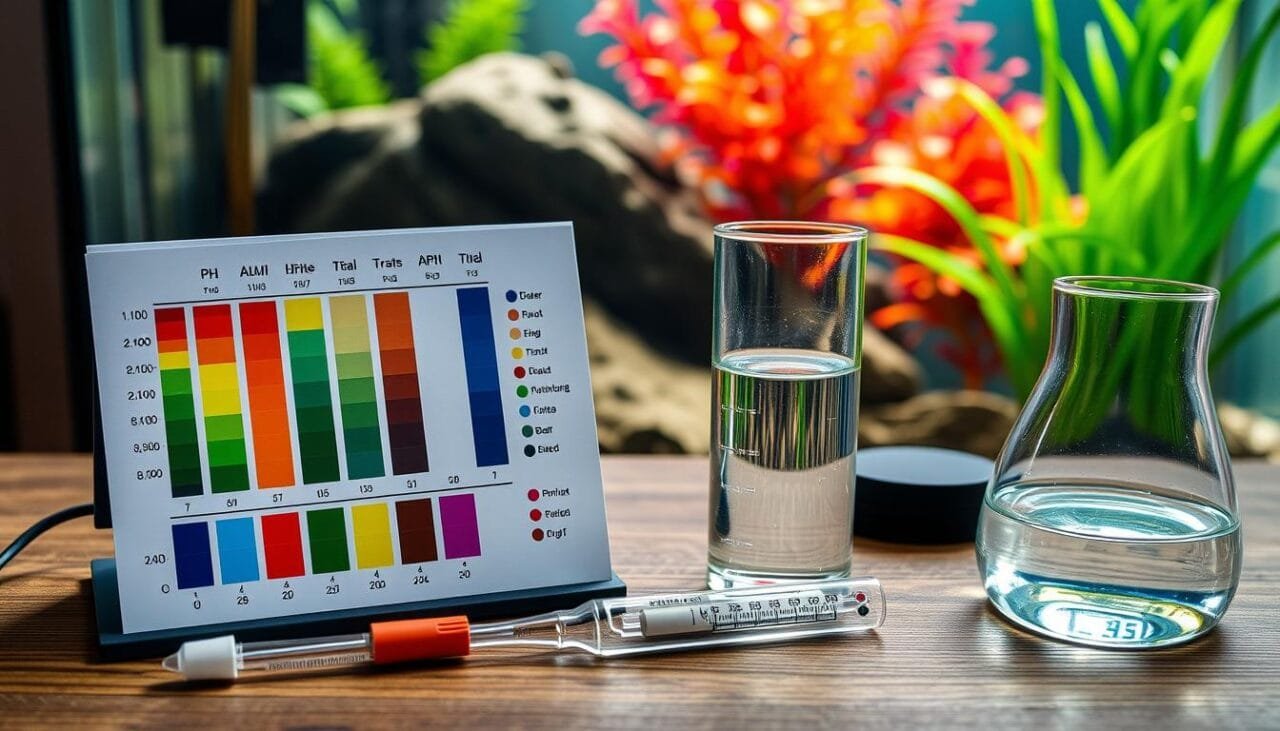
For a successful cycle, you need to test water often and accurately. The API Master Test Kit is top-notch for this. It gives you detailed info about your tank’s chemical makeup.
- Test ammonia levels every 1-2 days during cycling
- Monitor nitrite and nitrate concentrations carefully
- Use liquid test kits for more accurate results
During cycling, you’ll see certain ranges for each parameter:
| Parameter | Ideal Range | Action Needed |
|---|---|---|
| Ammonia | 0-3 ppm | Water change if above 5 ppm |
| Nitrites | 0-2 ppm | Monitor closely |
| Nitrates | 5-10 ppm | Partial water changes |
“Accurate testing is the key to a successful and healthy aquarium ecosystem.” – Aquarium Experts
pH levels are vital for testing nitrites and bacterial growth. Keep pH between 7.0 and 7.8 for best bacterial growth. Temperature also matters, aiming for 83°F to 87°F.
Be patient. Most aquariums need 4 to 8 weeks to cycle. Regularly testing ammonia, nitrites, and nitrates will help you through this important time. It’s all about creating a thriving aquatic home.
Common Cycling Problems and Solutions
Aquarium cycling isn’t always smooth sailing. Aquarists often face challenges that can upset the balance of beneficial bacteria and water chemistry. Knowing these common problems helps enthusiasts avoid them.
Managing Ammonia Spikes During Fish Tank Cycling
Ammonia spikes are a big worry during cycling. These sudden increases can harm the whole ecosystem. To tackle ammonia spikes, follow these steps:
- Monitor ammonia levels daily
- Keep ammonia concentrations below 0.5 mg/L
- Perform regular water changes
- Use high-quality bacterial supplements
Resolving Stalled Cycles
A stalled cycle happens when nitrite or nitrate production stops. To cycle your aquarium quickly, take action. Here are some solutions:
- Check water parameters
- Ensure enough organic matter for bacterial growth
- Maintain stable water temperature
- Consider transferring filter media from an established tank
Preventing pH Crashes
pH changes can harm beneficial bacteria. To avoid problems, keep pH stable and use buffers. Consistent water chemistry is key for successful tank cycling.
“The key to successful aquarium cycling is patience and careful monitoring.” – Professional Aquarist
Understanding these solutions helps create a healthy environment for fish. Remember, every tank is different. What works for one might need adjustments for another.
Plants and Cycling: A Beneficial Partnership

Live plants are key to a healthy aquarium. They add beauty and help during the cycling process. They soak up extra nutrients, keeping the water stable.
Aquarium ecosystem health relies on the right mix of nutrients and bacteria. Fast-growing plants help by:
- Quickly taking in ammonia
- Offering more space for beneficial bacteria
- Competing for nutrients as the tank balances
Good plants for cycling include:
- Hornwort
- Java Moss
- Anacharis
- Water Sprite
*”Plants are nature’s water purifiers, working silently to create a thriving aquatic environment.”*
But plants need care too. Make sure they get the right light, nutrients, and trimming. This keeps them working well for your tank’s health.
Maintaining Beneficial Bacteria After Cycling
Keeping a healthy aquarium bacteria colony needs careful attention and smart maintenance. The growth of fish tank bacteria depends on a good environment. This environment supports the delicate ecosystem built during the initial cycling process.
- Avoid overfeeding fish to prevent too much waste
- Do consistent but gentle water changes
- Use fewer chemical treatments to protect bacteria
- Keep water parameters stable
“Healthy tank bacteria are the silent guardians of aquarium ecosystem balance”
Water chemistry is key to keeping aquarium bacteria healthy. The best conditions include:
| Parameter | Ideal Range |
|---|---|
| pH Level | 7.0 – 8.5 |
| Temperature | 75-80°F |
| Water Hardness | 3-10 degrees |
Regular checks and gentle care will keep your aquarium’s bacterial ecosystem strong. This ensures it can handle waste well.
Time Management and Patience in Tank Cycling
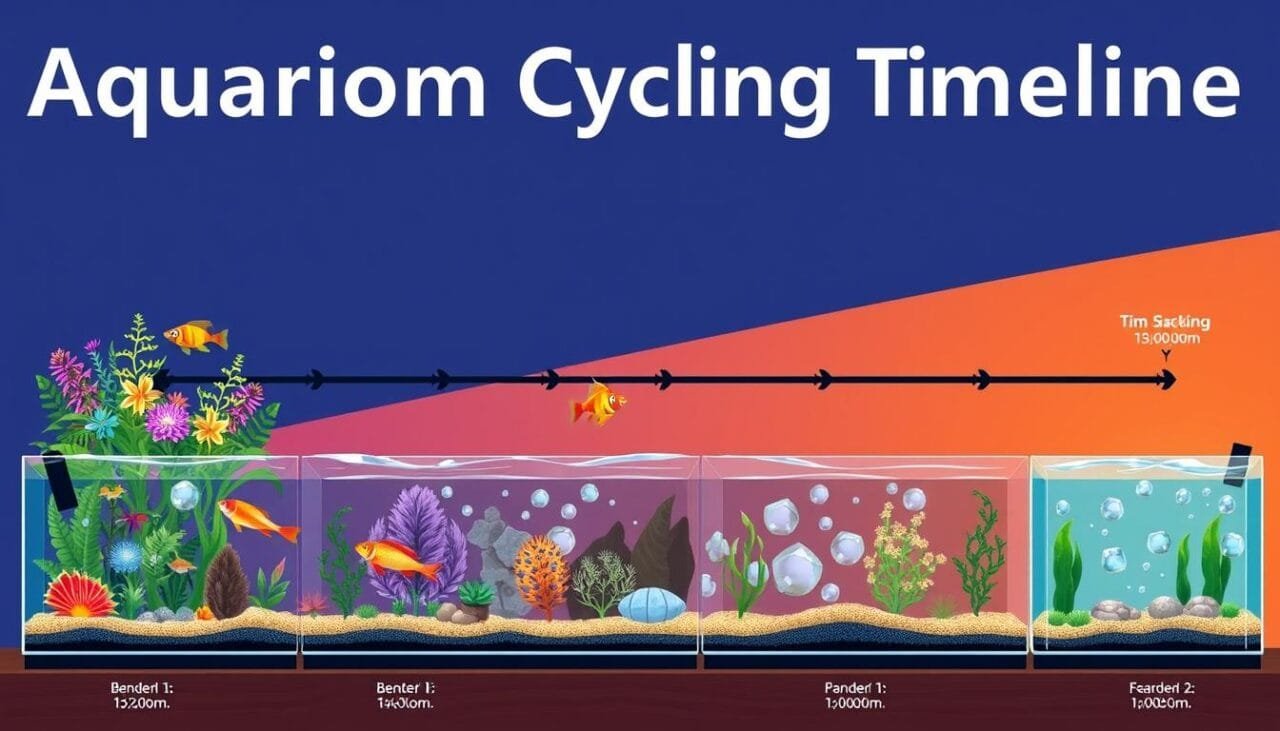
Understanding the importance of time and patience is key to mastering the aquarium cycle. This process usually takes 4 to 6 weeks. It’s a test of how dedicated you are to your aquarium. Successful tank cycling relies on letting beneficial bacteria grow naturally.
“Patience is the key to creating a thriving aquatic ecosystem.” – Professional Aquarium Specialist
The aquarium cycle has several stages that can’t be rushed. Several factors affect how long it takes:
- Water temperature
- Initial bacterial population
- Tank size
- pH levels
Cycling time can vary a lot based on these conditions. Smaller tanks cycle faster because they have less water. Bigger tanks need more time to get stable bacteria.
| Cycling Stage | Typical Duration | Key Characteristics |
|---|---|---|
| Ammonia Stage | 1-2 weeks | Initial bacterial growth begins |
| Nitrite Conversion | 2-4 weeks | Beneficial bacteria multiply |
| Nitrate Formation | Final stage | Cycle nears completion |
Experienced aquarists might speed up the cycle by adding filter media or bacterial supplements. But, always test the water regularly to keep conditions right.
Don’t rush the cycle. It can harm your fish. Being patient ensures a healthy aquarium.
Conclusion
Creating a healthy fish tank bacteria colony is vital for your aquarium’s health. It’s not just a technical task; it’s the heart of your underwater world. The cycling process shows us the importance of patience and watching closely.
Managing ammonia levels and knowing how bacteria grow are key. These aquarium care tips help make your tank stable and lively.
Keeping your tank healthy requires constant care, mainly in the first few weeks. This period can last from 2 to 20 weeks, based on several factors. Your tank will change from a simple container to a living, breathing space.
Live plants can speed up this change. They soak up extra ammonia and help keep the water balanced.
The goal is to have a balanced home for beneficial bacteria, plants, and fish. Regular water tests, watching nitrite and nitrate levels, and knowing the nitrogen cycle are important. Every tank is different, so what works for one might need tweaks for another.
By dedicating time to learn and apply the right cycling methods, you’ll get a stunning, healthy aquarium. The effort you put in will pay off with a vibrant underwater world. It will bring happiness and peace to your home. Enjoy the journey and watch your tank thrive.
FAQ
How long does it take to cycle a fish tank?
Cycling a fish tank usually takes 4-6 weeks. This time can vary based on factors like water temperature and the presence of bacteria. Always be patient to ensure a healthy tank.
Can I add fish during the cycling process?
Adding fish during cycling is not recommended. It can be stressful for them due to harmful toxins. It’s better to cycle the tank without fish to keep them safe.
What are the signs that my tank is fully cycled?
A cycled tank shows zero ammonia and nitrites, with nitrates present. When you add ammonia, it quickly turns into nitrates. Your test kit will show stable readings, meaning the bacteria are ready.
Do I need special products to cycle my tank?
Special products can help cycle your tank faster. You’ll need a water conditioner to protect bacteria. Bacterial starters, a good test kit, and ammonia can also be useful.
Can live plants help with cycling my aquarium?
Yes, live plants are great for cycling. They absorb nutrients, provide surfaces for bacteria, and can speed up the process. Plants like Java Fern and Amazon Sword work well.
What temperature is best for cycling a fish tank?
The best temperature for cycling is 75-80°F (24-27°C). This helps bacteria grow well. Use a heater to keep the temperature stable.
How often should I test water parameters during cycling?
Test water every other day or twice a week during cycling. Use a liquid test kit for ammonia, nitrites, and nitrates. As the cycle stabilizes, test less often.
What happens if my tank cycle stalls?
A stalled cycle can happen for several reasons. To restart, ensure a steady ammonia source and correct water conditions. A bacterial supplement can also help.
Can I use water from an established tank to speed up cycling?
Yes, using water from a healthy tank can speed up cycling. This method introduces beneficial bacteria. Make sure the source tank is disease-free.
Is it normal to see cloudy water during cycling?
Cloudy water during cycling is normal and usually harmless. It means bacteria are growing. The water should clear as the bacteria stabilize. Avoid making too many water changes.
